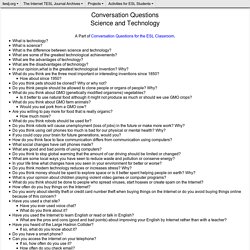

Smithsonian National Museum of Natural History. BBC Science. Brains on! A podcast for kids & curious adults. Science and Technology. A Part of Conversation Questions for the ESL Classroom.

Pseudoscience Examples. Pseudoscience In short, pseudoscience may be called false science.

The term is used to describe something that may be reported or recorded as a product or real science, but actually there is no connection to proper scientific methodology and cannot be proven realistically. Evidence may be produced to support something, but it is not empirical evidence, which is evidence collected by observation and experimentation. True science uses a particular methodology to conduct research.
It is based on fundamental principles, widely accepted theories, and the research can be replicated, which can back up a scientists work. Often, television dramas and plots are based on pseudoscience. Examples of Pseudoscience: 1. Aliens may have visited the Earth and influenced civilization or created the crop circles, even though there is no empirical evidence existing. 2. Pseudoscience is used to try and prove that the original moon landing did not happen or that the Earth is flat and disc-shaped. 3. 4. 101 science and health myths debunked. Common Science Myths That Most People Believe.
There are a number of old wives’ tales out there regarding some basic scientific principles.

Though most of them were refuted years ago, these rumors just won’t go away. Here are some of the top myths floating around out there that just aren’t true: We only use 10% of our brains. It's true that there’s a great deal we don’t know about the brain, but we certainly do know that we use our entire brain. Even if we didn’t have a wealth of data from brain scans to show this 10% figure is completely false (we do), it doesn’t even make sense using basic logic. Additionally, there is no evidence that someone was ever diagnosed with a brain tumor but was told: “Great news! While you might not be using every bit of your brain at all times, but you do use the entire brain over the course of the day.
There is a dark side of the moon. Oh, Pink Floyd, how you have led us all astray. From our perspective on Earth, we are able to view about 59% of the moon’s surface (though not all at the same time). Proof of evolution that you can find on your body. News and feature articles from all fields of science. Insight Into the Teenage Brain: Adriana Galván at TEDxYouth@Caltech. The Learning Brain. The Teenage Brain Explained. Science News for Students. It’s not easy being a teenager.

The teen years can play out like a choose-your-own-adventure novel, where everyday temptations lead to tough decisions. What if I took that big jump on my bike? What’s the worst thing that could happen if I snuck out after curfew? Should I try smoking? Teenagers must act on an endless parade of choices. So what makes the teenager’s brain so complex? The evolved teenager If you have ever thought that the choices teenagers make are all about exploring and pushing limits, you are on to something. For example, laboratory experiments show that young mice stay close by their mothers for safety. As a developmental cognitive neuroscientist, Luna studies those changes that occur in the brain as children develop into adults. Jackpot! What really goes on in a teenager’s brain? Eveline Crone is a psychologist at Leiden University in the Netherlands who studies how the brain develops. A young boy prepares to enter a magnetic resonance imaging (MRI) scanner.
The Lighter Side of Science. Proof of evolution that you can find on your body. Parasites. Falling. When Brains Attack! The Good Show. Choice. Logic and emotion aren't the only forces that guide our decisions.

This hour of Radiolab, we turn up the volume on the voices in our heads, and try to make sense of the babble. Forget free will, some important decisions could come down to a steaming cup of coffee. UPDATE: The Williams & Bargh Yale coffee study "Experiencing Physical Warmth Promotes Interpersonal Warmth" was replicated in 2014 by researchers at three different universities, Kenyon College, Michigan State University, and University of Manchester.
They did not observe the same results as in the original study. They conclude that the difference between the original and the replications may have been due to some issues with the methods of the original study ("The effect observed by Williams and Bargh may have been due, in part, to unconscious cues given by the researcher") or may simply have been due to chance. Laughter. Placebo. Sleep. Only Human. Brains On! Science Vs - Season 1. Proof of evolution that you can find on your body. BrainStuff. The Naked Scientists Podcast.